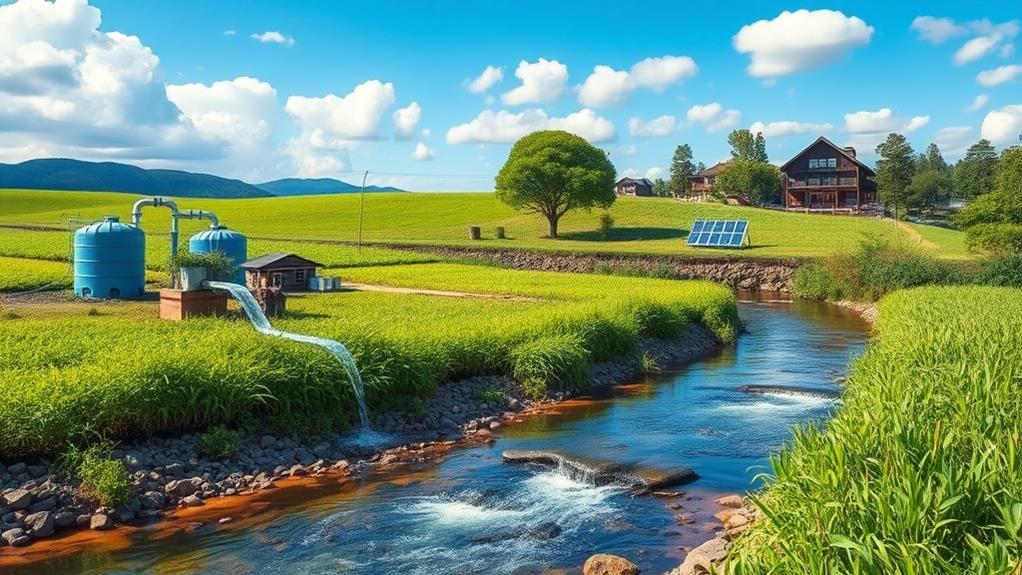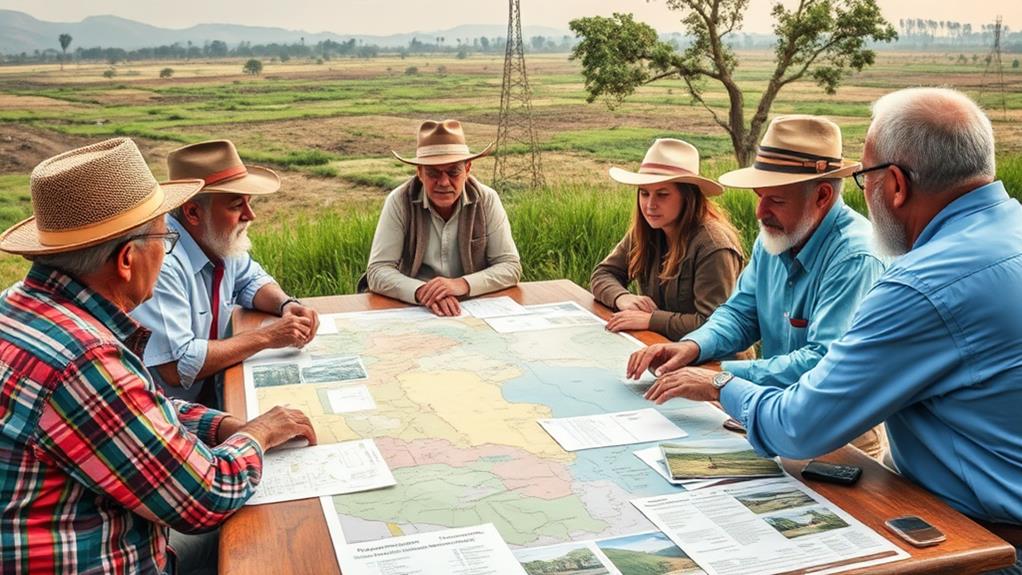Adapting to climate change in natural resource sectors is important for keeping ecosystems healthy.
Strategies like habitat restoration, watershed management, and stakeholder collaboration are crucial for handling risks from higher temperatures and severe weather.
For example, restoring natural water flow can improve water supply. Similarly, managing upland vegetation helps protect biodiversity.
Involving local communities in these efforts leads to better solutions because it brings in different ideas.
Monitoring adaptation strategies is necessary to make changes based on new conditions.
By using holistic approaches, we can improve resilience to climate challenges and manage resources better. Holistic approaches take into account the interconnectedness of different systems within the environment and society, allowing for more comprehensive and sustainable solutions. By integrating traditional knowledge, local practices, and modern science, communities can develop strategies for coping with changing climate and reducing vulnerability to its impacts. This can include implementing sustainable land management practices, promoting renewable energy sources, and creating adaptive infrastructure to withstand extreme weather events.
Understanding Climate Change Impacts

Climate change has a significant impact on ecosystems and natural resources. Global average temperatures have increased by about 1.2°C since the late 1800s. This rise leads to more extreme weather events, such as hurricanes, droughts, and floods, which disrupt ecosystems and make communities less resilient.
For example, heavy rainfall can cause floods that wash away crops, while droughts can reduce water supplies.
Biodiversity is also at risk due to climate change. An estimated 1 million species face extinction because of changes in their habitats and environmental pressures. For instance, ocean acidification, caused by high CO2 levels, lowers the pH of ocean water, harming marine life and coral reefs.
As habitats change, species may move to new areas or decline, which can negatively affect industries that rely on these resources.
Understanding these impacts is essential for effective adaptation. Recognizing how ecosystems and human needs are connected helps highlight the urgency of addressing climate challenges.
Key Adaptation Strategies
Adaptation strategies are important for helping natural resource sectors deal with climate change. Restoring the hydrologic function of watersheds is one key strategy. This means improving how water moves through land, which can help ecosystems recover and reduce the negative effects of climate change on water supplies.
In fisheries management, keeping natural flow patterns in rivers is essential. This helps maintain healthy aquatic habitats and ensures fish populations can thrive even as temperatures change. For example, cooler water areas can be protected to support fish during hot weather.
Another important tactic is managing upland vegetation. Protecting special areas known as refugia helps keep different plant species alive and strong against challenges other than climate change. It's better to focus on healthy ecosystems rather than individual plant species.
Habitat restoration in places like riparian areas, wetlands, and ecosystems that rely on groundwater is also crucial. This includes maintaining natural water flow and improving the health of soil and streambanks.
These actions support the overall health of the environment and make it more resilient to climate change.
Water Supply Resilience

Water supply resilience is important due to climate change. To improve this resilience, we need to restore how watersheds function.
Restoring watersheds enhances natural filtration and storage. This helps to provide a more reliable water supply.
Connecting floodplains is also crucial. It allows ecosystems to absorb and distribute excess water during extreme weather, which protects water sources.
Supporting groundwater-dependent ecosystems is key for areas facing drought. This strategy helps keep water clean and available, making it essential for adapting to climate change.
Managing valley storage capacity is another important practice. It can lessen the effects of extreme weather and secure a steady water supply.
Reducing fire hazards is vital for protecting water sources. Proactive vegetation management can prevent both damage to water supply and overall ecosystem health.
By combining these strategies, we can significantly improve water supply resilience. This creates a strong foundation for managing resources sustainably in a changing climate.
Fisheries Management Approaches
Effective fisheries management is essential for keeping fish populations healthy and maintaining strong aquatic ecosystems. To adapt to changes, it's important to use adaptive management strategies. For example, preserving natural flow in streams helps protect fish habitats and strengthens their ability to cope with climate change.
Improving water temperature is important for fish species. As water gets warmer, providing cooler areas in streams can make these environments better for fish.
Additionally, reducing barriers in streams allows fish to move freely, which is vital for their survival and reproduction.
Using geospatial data on stream temperatures and geological hazards helps in making smart decisions for sustainable fisheries. This data can guide actions to maintain healthy fish habitats.
Moreover, practicing water conservation is critical. Keeping water levels stable supports fish and the overall health of aquatic environments.
By following these strategies, you can support fish populations and strengthen aquatic ecosystems. Your efforts in fisheries management contribute to long-term sustainability.
Upland Vegetation Strategies

Healthy aquatic ecosystems depend on strong upland vegetation. These areas support waterways and boost biodiversity. To help plants adapt to climate change, use methods like controlled burns and selective logging. These techniques can reduce the negative effects of climate change on upland vegetation.
It's important to protect refugia, which are places that stay mostly undisturbed by climate stressors. These areas help maintain biodiversity and provide homes for vulnerable species. Increasing the resilience of native vegetation against threats like invasive species and land-use changes is essential for healthy upland ecosystems.
Also, you should protect both genotypic (genetic) and phenotypic (physical) diversity in plant populations. This diversity improves their ability to adapt to environmental changes.
By focusing on functional systems instead of just individual species, you take a more complete approach to managing upland vegetation. This method supports important ecosystem services and strengthens these landscapes against climate change.
Habitat Restoration Efforts
Habitat restoration is important for making ecosystems stronger. To achieve this, we must focus on restoring natural water flow in sensitive areas. These actions help improve the health of ecosystems and lessen the negative effects caused by climate change.
First, keep the right number of plants in an area. This helps support biodiversity and prevents soil erosion. For example, planting different types of native plants can attract various animal species and protect soil from washing away during heavy rains.
Second, target important areas such as riparian zones and wetlands. These areas are crucial for many species. For instance, riparian zones along rivers provide habitats for fish and birds, while wetlands filter water and store floodwaters.
Third, use geospatial data to make restoration efforts more effective. This data helps identify specific problems in each area. For example, mapping areas with poor soil health can guide where to focus planting efforts.
Finally, improve soil health and stabilize streambanks. Healthy soil supports plant growth, and stable streambanks reduce damage from floods. For example, adding organic matter to the soil can enhance its quality and help plants grow better.
By following these steps, habitat restoration helps ecosystems become stronger and better prepared for climate change.
It's essential to understand how different factors interact in the environment. Working with others in different fields can lead to better and more sustainable restoration practices, resulting in healthier ecosystems that can survive future climate challenges.
Stakeholder Coordination for Success

Successful coordination among stakeholders is essential for creating effective strategies to adapt to climate change in natural resource management. Engaging local communities, governments, and organizations helps bring together different viewpoints and expertise, leading to better solutions for climate challenges.
For example, working with local farmers can help identify the best practices for conserving water in drought-prone areas.
The UNFCCC emphasizes the need for gender-responsive and transparent engagement. This means including both scientific research and traditional knowledge in adaptation efforts.
For instance, combining modern agricultural techniques with local farming practices can create more effective methods for crop resilience.
Monitoring and evaluating these strategies is important. This allows teams to adjust their plans based on changing climate conditions.
For example, if a certain crop fails due to unexpected weather, farmers can shift to more resilient varieties in future planting seasons.
Natural resource professionals should adopt a teamwork approach. This ensures that all community voices are included, leading to solutions that are both scientifically valid and culturally acceptable.
Future Directions for Adaptation
The future of adaptation in natural resource sectors depends on using new technologies and teamwork. To succeed, these strategies must include input from local communities and experts.
Key areas for future focus include:
- Innovative Technologies: Use tools like remote sensing, which is satellite technology that helps track climate changes, and data analytics, which analyzes information to manage resources better.
- Interdisciplinary Research: Work across different fields to fill in knowledge gaps about how ecosystems interact, which helps in making better management decisions.
- Funding Mechanisms: Use funding initiatives, such as the Glasgow Dialogue from COP 26, to obtain money needed for adaptation projects.
- National Adaptation Plans: Create and follow National Adaptation Plans (NAPs) to ensure countries are accountable and committed to improving resilience.
Questions and Answers
What Is Adaptation and Building Resilience to Climate Change?
You adapt to climate impacts by improving your ability to handle changes through sustainable practices. For example, planting trees can help reduce flooding and improve air quality. This method boosts ecosystem services, which are natural benefits like clean water and healthy soil. These services help communities cope with disturbances such as storms or droughts. By maintaining these ecosystems, we can ensure better support for people and protect the environment.
How Do You Build Resilience Against Climate Change?
To build resilience against climate change, engage your community. This means working together with your neighbors and local groups to share ideas and resources. For example, organizing community clean-up events can help improve local environments.
Adopt sustainable practices in your daily life. This includes recycling, using energy-efficient appliances, and reducing water usage. For instance, switching to LED light bulbs can lower energy consumption and save money.
Integrate effective policies at the local and national levels. Governments can create laws that protect natural resources and encourage green energy. An example is offering tax breaks for families that install solar panels.
Leverage technological innovations to combat climate change. This includes using advanced farming techniques or renewable energy sources like wind and solar. For example, smart irrigation systems can help farmers use less water while still growing healthy crops.
These strategies improve our ability to adapt and ensure a stable environment for the future.
What Are the 4 Adaptation Strategies for Climate Change?
To adapt to climate change, there are four main strategies: strong policy frameworks, community engagement, technological innovation, and effective ecosystem management.
Strong policy frameworks involve creating laws and guidelines that help manage climate risks. For example, governments can set regulations that limit greenhouse gas emissions to reduce overall pollution.
Community engagement means involving local people in decision-making. This can include organizing workshops to educate citizens on climate issues and encouraging them to participate in sustainability projects, like community gardens.
Technological innovation refers to using new technologies to address climate challenges. For instance, solar panels and wind turbines are examples of renewable energy sources that reduce reliance on fossil fuels.
Effective ecosystem management focuses on protecting and restoring natural environments. This can involve reforesting areas to enhance biodiversity and improve carbon storage, which helps combat climate change.
These strategies together ensure that communities can adapt to and thrive despite environmental changes.
What Is Resilience Theory in Climate Change Adaptation?
Resilience theory in climate change adaptation focuses on understanding how ecosystems work and how communities can respond to changes. For example, knowing how a forest recovers after a wildfire helps us create better plans for protecting it in the future. It also highlights the importance of social connections. Communities with strong ties can work together more effectively to deal with climate impacts, like flooding. Finally, it stresses the need for good policies. These policies should be based on careful assessments of risks, like identifying areas most likely to flood and creating strategies to protect them.